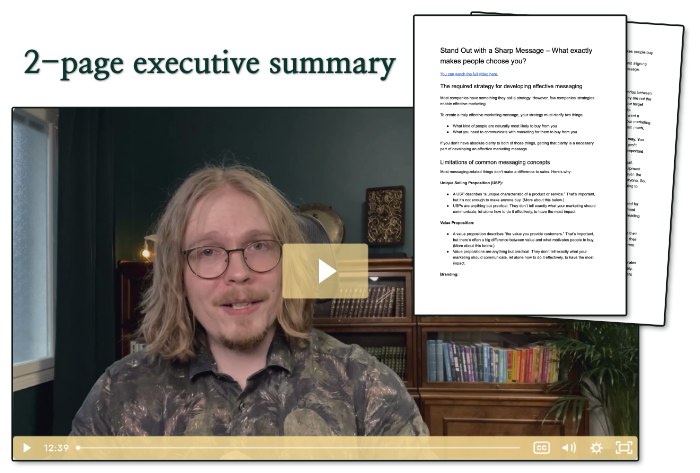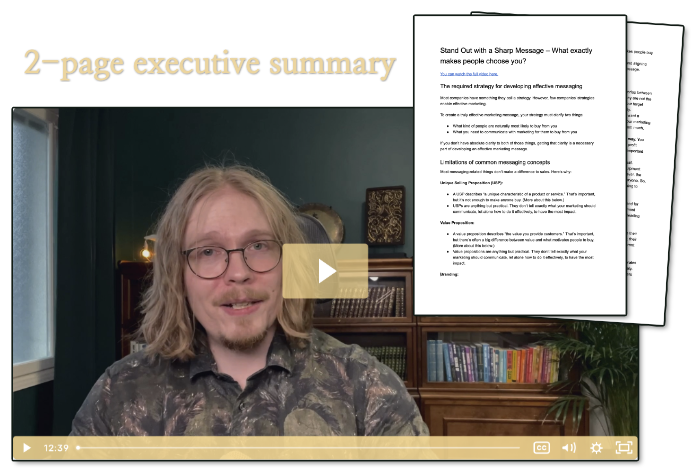Have you ever knocked on the side of a fish tank and felt betrayed by the goldfishes that ignored you?
You push your face against the side, yell at them—loudly enough to wake up a fossil—or serve their favorite purple treats that smell like chicken poo, and they’re still more fascinated by the water around them than you.
Does your website or marketing efforts remind you of that fish tank? No matter what you do, no one notices.
It could be that people have the attention span of a goldfish.
Depending on the goldfish, it’s somewhere between three and 10 seconds. (That’s actually a myth, but you get the idea.)
That’s how long you have to turn apathy into solid interest or risk losing your visitors and prospects to other sites and businesses.
Understanding what makes people excited about your message is the key to effective writing and marketing.
People are wired to make snap decisions
The average person sees 1,000-10,000 marketing messages per day (depending on the source you believe).
Add all other messages to that mix, and it’s clear you can’t process all of them consciously.
Instead, your brain makes snap judgements.
If what you see isn’t what you need or something surprising, you won’t even notice it; your brain decides it’s not worth wasting time on.
To grab your visitors’ interest, give them exactly what they want or hit them in the head with something completely unexpected.
The first headline they see has to be irresistible. If it isn’t, they click the “back” button.
In fact, visitors click that button the moment they lose interest anywhere on the site.
Are you interesting?
Why would anyone stay on your site if it doesn’t engage them?
People won’t try to find something useful or inspiring. Instead, you need to put it right in front of them immediately or they leave.
This might not seem related to conversion optimization, but writing about something your visitors don’t care about is one of the most common conversion problems I see.
There are only two things people are really interested in:
- Problems they want to solve
- Goals they want to achieve
Entertainment doesn’t necessarily fit in either of those categories, but people are drawn to it. However, it’s difficult to use as effectively as the other two.
Writing about anything other than reader problems and goals is a risk.
Just like any risk, it can pay off, but you should take it only when the pay-off is pretty certain.
If you’re not sure,just avoid writing about other topics altogether.
But it’s not quite enough to write about the right topic.
The visitors’ point of view
People are essentially more interested in themselves than they are in you or anyone else. (Note for romantics: even if you put someone else’s needs ahead of your own, effective marketing focuses on your interests, and that can be somebody else’s needs.)
As long as you focus on the readers, you have a fair chance of keeping them captivated.
The moment you wander to topics they don’t care about, they tune out.
It’s not enough to write about their problems or goals; you need to write from the readers’ point of view.
For example, “I can show you how to lose weight” is written from the writer’s point of view, while “You’ll lose weight and feel good” is the reader’s point of view.
The difference is sometimes hard to detect, but it can increase your conversion rates significantly.
Imagine someone reading what you wrote out loud. Would it sound like they’re talking about themselves? Or would it sound like they’re talking about you, the listener?
If it’s not clearly focused on the listener, you can expect a low conversion rate.
That applies to all copywriting (and writing in general) whether it’s a sales page, home page, or a blog post.
Be the reader’s best friend
A good best friend is someone who listens to you, cares about you, and is interested in your opinions. They don’t constantly talk about themselves.
If you write like a best friend, people want to read it, and they might even like you.
Being a good friend also means that you help them. And that help can be something you charge for.
Assuming you’re running a business (or even if you’re writing a blog “just for fun”), you need people to take action. You need them to buy your products or services, join your email list, and/or share your content with their networks.
For many people, finding the balance between being the best friend and asking for the sale is difficult; they either come off as pushy or they don’t even try to sell anything.
It doesn’t have to be like that.
Being helpful and selling something are not opposites even though many people feel that way.
How you create the balance depends on your business. And it’s a topic for another article.
But even if you find the perfect balance, you still need to be interesting.
Otherwise, the goldfishes—your readers—won’t care about what you have to say.
Write about their problems and goals from their point of view.
Offer them help, even if it costs them something. Just do it as a friend.
If you need help finding the right way to offer your products or services to people, I’d love to help. You can reach out to me directly, so we can talk.
If you know someone who’s struggling to keep people reading what they have to say, give them a link to this article. You might save them months of frustration as they try to figure out why people don’t seem to care about what they have to say.


